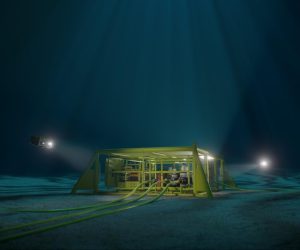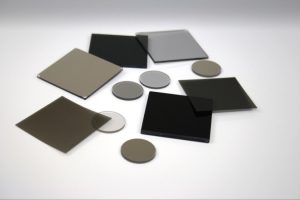Innovations in Robotics for Enhanced Operations in the Subsea Sector
8th Apr 2024Thanks to their rapid growth, robots continue to deliver increasingly sophisticated processes to the subsea industry that enable professionals to explore new frontiers in renewables, mining, telecommunications, defence and security, research and exploration and ecological observation. Without them, not only would safety risks be significantly higher, but there would also be several challenges, such as entry to hard-to-access underwater spots and a considerable drop in efficiencies. In this blog, we delve into some robotic enhancements and examine some of the optical components used in their fabrication.
 Submersible robots present numerous gains for oil and gas enterprises, subsea engineering and construction firms, nautical science institutions, telecom businesses, and the military. Aside from the glaring safety, accessibility, and productivity benefits, there are additional perks, such as accuracy, valuable information gathering, and extended running times. They are also noted to reduce the environmental impact of aquatic objectives.
Submersible robots present numerous gains for oil and gas enterprises, subsea engineering and construction firms, nautical science institutions, telecom businesses, and the military. Aside from the glaring safety, accessibility, and productivity benefits, there are additional perks, such as accuracy, valuable information gathering, and extended running times. They are also noted to reduce the environmental impact of aquatic objectives.
Given their pros, these bots have become integral to the workforce, leading to the advancement of various types adapted to different duties, encompassing:
Remotely Operated Vehicles (ROVs)
 Since their introduction in the 1960s, ROVs have been pivotal in advancing subsea exploration, research, industrial procedures, and naval defence methods. Over the past 64 years, they’ve evolved substantially, transcending their origins as cable-connected models controlled from the surface to independent marvels with cutting-edge features.
Since their introduction in the 1960s, ROVs have been pivotal in advancing subsea exploration, research, industrial procedures, and naval defence methods. Over the past 64 years, they’ve evolved substantially, transcending their origins as cable-connected models controlled from the surface to independent marvels with cutting-edge features.
Today, they boast an array of high-level skills, including autonomy, real-time data transmission, and cloud-based processing. The transformation has revolutionised their capabilities, driving innovation and expanding the horizons of what’s possible in undersea activities.
Head in the Clouds
Internet-centric ROVs, in particular, are emerging as game changers, permitting operators to work from anywhere globally. An excellent example of this is HonuWorx’s solution, HonuMove. Demonstrated from many locations in the UK and the USA using an observation-class vehicle, HonuMove showcases the power of cloud architecture in enabling remote piloting and access to live tasks [1].

Harnessing Humanoid Movement
With the evolving interest in offshore power generation and net-zero goals on the horizon, we’re seeing more ROVs being used extensively in the renewables arena. Here, they’re regularly relied upon for comprehensive inspection, cleaning and attaching and removing shackles on fixed or floating wind farms.
One significant challenge in these circumstances is efficiency and accuracy in dynamic under-the-surface atmospheres. To help tackle this, Honda has unveiled a groundbreaking ROV concept specifically for offshore applications featuring arm attachments that revolutionise manipulation precision and stability. Drawing inspiration from its ASIMO humanoid robot, the world-renowned Japanese brand has incorporated advanced cooperative control technology, mitigating the lag between an ROV’s body and its arms, compensating for the ocean current’s disruptive effects on object alteration. Just as ASIMO seamlessly integrates torso and limb movements, Honda’s manipulator-ROV system strives to streamline these duties with synchronised control [2].
What Viewports Are Typically Used in ROVs?
For optimisation and protection of vision systems in ROVs, premium optical windows are frequently incorporated into the manufacturing of these instruments, comprising:
 Domes: Usually brought in to protect cameras and lights mounted onto ROVs, Optical Domes are generally assigned in Acrylic substrates; however, N-BK7 (or its equivalent), Sapphire, and UV-Fused Silica are other widely used material options. Domes are known to present a wider field of view, desired structural integrity in high-pressure subaquatic habitats, and reduced drag as ROVs move through the water.
Domes: Usually brought in to protect cameras and lights mounted onto ROVs, Optical Domes are generally assigned in Acrylic substrates; however, N-BK7 (or its equivalent), Sapphire, and UV-Fused Silica are other widely used material options. Domes are known to present a wider field of view, desired structural integrity in high-pressure subaquatic habitats, and reduced drag as ROVs move through the water.
 Windows: Flat Windows are an alternative suitable option for ROVs that require specific optical properties or where space and cost variables favour flat viewports. Typical substrate materials include BK7 (or its equivalent), Sapphire, and Gorilla Glass.
Windows: Flat Windows are an alternative suitable option for ROVs that require specific optical properties or where space and cost variables favour flat viewports. Typical substrate materials include BK7 (or its equivalent), Sapphire, and Gorilla Glass.
Autonomous Underwater Vehicles (AUVs)
Unlike ROVs, pre-programmed AUVs normally work independently without the requirement of human piloting. In some cases, this naturally results in a higher volume of state-of-the-art apparatus on the vessel – for instance, sensors, cameras, and navigation systems – so some models may call for a more extensive variety of optics.

What Lenses & Filters Are Popular For AUVs?
It’s worth noting that while AUVs and ROVs are intended for defined missions, a common thread among them is the utilisation of optical components, such as:
 Lenses: With cameras being pivotal in revealing what lies beneath the waves, Lenses are indispensable. Given the diverse atmospheric conditions, these optical elements vary from Wide-Angle Lenses for panoramic views to niche alternatives tailored for capturing detailed, close-up footage.
Lenses: With cameras being pivotal in revealing what lies beneath the waves, Lenses are indispensable. Given the diverse atmospheric conditions, these optical elements vary from Wide-Angle Lenses for panoramic views to niche alternatives tailored for capturing detailed, close-up footage.
 Filters: Optical Filters play a crucial role in achieving superior imaging. They are essential for reducing glare, improving contrast, and isolating certain spectral bands. In-demand varieties include Neutral-Density (ND), Polarising, and Bandpass Filters, each contributing to optimising image clarity.
Filters: Optical Filters play a crucial role in achieving superior imaging. They are essential for reducing glare, improving contrast, and isolating certain spectral bands. In-demand varieties include Neutral-Density (ND), Polarising, and Bandpass Filters, each contributing to optimising image clarity.
Military AUVs
Alongside their use for oceanographic research and subsea cable maintenance, navies employ AUVs for everything from underwater mapping and charting and mine countermeasures (MCM) to submarine detection, tracking, and surveillance.
The U.S. Navy, in particular, is a great adopter of high-spec AUVs and has recently chosen three companies to deploy models for underwater combat. Kongsberg, Oceaneering, and Anduril have been tasked with creating prototypes for long-range, large, crewless submarines, addressing urgent procurement needs on a tight schedule. Notably, Anduril, an Australian company, has used 3D printing tech to construct a sub prototype, allowing for greater flexibility in adapting the vessel’s shape to meet specific payload requirements [3].
Unmanned Surface Vehicles (USVs)
Often applied in conjunction with ROVs and AUVs, USVs can be used for a series of assignments, such as supporting AUV deployment, working alongside underwater devices in search and rescue missions, and relaying communication.
In fresh USV announcements, two leaders in hydrogen technology have just joined forces to pioneer the development of next-generation hydrogen-powered Unmanned Surface Vehicles (H-USVs), elevating the standard for low-emission USVs in ocean monitoring and data collection. The collaboration aims to integrate a commercially certified marine fuel cell, enhancing payload capacity and power output for improved performance and efficiency [4].
Small USVs (sUSVs)
The U.S. Navy is also calling for small USVs (sUSVs) to intercept hostile boats in the Middle East. The request is that they must be capable of travelling long distances, staying in a specific area to watch for ships, and rapidly moving to stop ships that aren’t cooperating [5].
What Optical Equipment is Integrated into USVs?
Even though these vehicles operate above the water’s surface, they still need specialised optical components. Typically outfitted with multiple cameras, optical encoders, sensors, and LiDAR (light detection and ranging), the optics within the onboard tools may necessitate special coatings to guarantee seamless operation and reliability.
Optical Coatings selected to optimise the functionality involve:
 Hydrophobic: Helps to prevent water droplets from adhering to the surface of optics to ensure visibility and sharpness for cameras, sensors, and windows exposed to rain, spray, or humidity.
Hydrophobic: Helps to prevent water droplets from adhering to the surface of optics to ensure visibility and sharpness for cameras, sensors, and windows exposed to rain, spray, or humidity.
Oleophobic: To deter smudges and stains. This coating is commonly specified to keep Lenses and Windows clear of fingerprints and other greasy substances that may affect image quality or sensor effectiveness.
Anti-Reflective (AR): Reduces reflections and glare, refining light transmission and boosting optical performance in USV cameras, sensors, and other imaging systems.
FOOTNOTES: